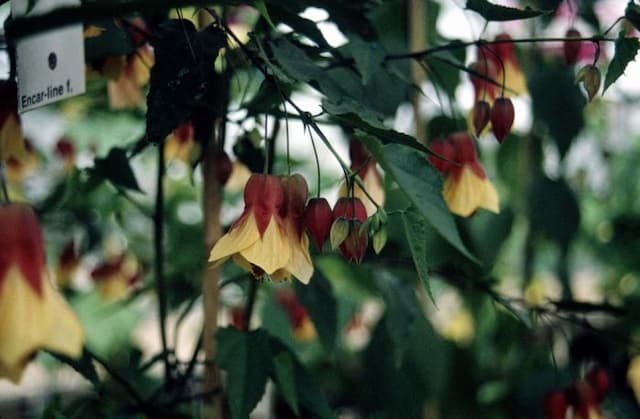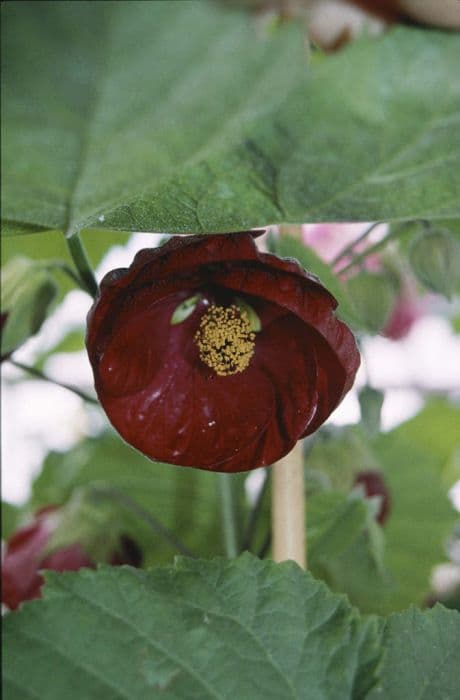Prairie mallow 'Elsie Heugh' Sidalcea 'Elsie Heugh'

ABOUT
'Elsie Heugh' is a clump-forming deciduous perennial with rounded basal leaves, lobed stem leaves and racemes of silky mauve-pink flowers 5cm across, with fringed petals, opening in early and mid summer
About this plant
 Names
NamesFamily
Malvaceae
Synonyms
Prairie Mallow, Miniature Hollyhock, Checker Mallow
Common names
Sidalcea 'Elsie Heugh'.
 Characteristics
CharacteristicsLife cycle
Perennials
Foliage type
Deciduous
Color of leaves
Green
Flower color
Pink
Height
2-3 feet (0.6-0.9 meters)
Spread
1-2 feet (0.3-0.6 meters)
Plant type
Herb
Hardiness zones
5
Native area
North America
Benefits
 General Benefits
General Benefits- Attractive Flowers: The Sidalcea 'Elsie Heugh', commonly known as checkerbloom, produces pink, hollyhock-like flowers that can add a touch of charm and color to any garden.
- Pollinator Friendly: It attracts butterflies and bees, supporting the local ecosystem and pollination processes.
- Drought Tolerant: Once established, checkerbloom is quite drought-tolerant, making it suitable for gardens in drier climates or for water-wise landscaping.
- Deer Resistant: The plant is generally resistant to deer, which makes it easier to grow without the need for protective measures.
- Easy to Grow: Checkerbloom is known for being easy to cultivate, which is ideal for beginner gardeners or those who prefer low-maintenance plants.
- Herbaceous Perennial: As a perennial, it will return year after year, providing a long-lasting addition to gardens.
- Cottage Garden Appeal: The plant's traditional appearance is perfect for cottage-style gardens where a more natural and whimsical aesthetic is desired.
- Summer Blooming: Checkerbloom blooms in the summer, filling the gap when many other plants have finished their spring show.
- Soil Adaptability: It can adapt to a range of soil conditions, although it prefers well-drained soils, making it versatile for different garden settings.
- Border Planting: With its upright growth habit, it serves as an excellent choice for borders or for adding vertical interest to garden beds.
- Cut Flowers: The flowers can be used in cut flower arrangements, bringing the beauty of the garden indoors.
- Low Pest Problems: Checkerbloom generally has few problems with pests, reducing the need for chemical treatments in the garden.
 Medical Properties
Medical PropertiesThis plant is not used for medical purposes.
 Air-purifying Qualities
Air-purifying QualitiesThis plant is not specifically known for air purifying qualities.
 Other Uses
Other Uses- Sidalcea 'Elsie Heugh', commonly known as the prairie mallow, can be used in fabric dyeing for producing subtle pinks and purples, depending on the mordant used.
- The prairie mallow is suitable for pressed flower crafts due to its vibrant colors and the relatively flat shape of its flowers when pressed.
- The fibrous stems of prairie mallow can be repurposed into a natural twine for garden use like supporting other plants or creating rustic crafts.
- The leaves of the prairie mallow can be used in composting as a 'green' layer to add necessary nitrogen to the compost mix.
- Young prairie mallow plants can serve as living mulch, their foliage helping to retain soil moisture and suppress weeds when planted densely.
- Dry prairie mallow flower stalks can be used as natural garden stakes for supporting other lightweight blooms or as guides for seed rows.
- When dried, prairie mallow flowers can be incorporated into potpourris to naturally scent indoor spaces with their subtle fragrance.
- The prairie mallow's vibrant flowers can serve as a natural food-safe coloring for decorating desserts or in crafting edible flower petal confetti.
- Prairie mallow can be used in educational settings to demonstrate plant structure, pollination, and growth patterns to students.
- Prairie mallow seed pods can be used artistically in dried floral arrangements or as rustic decorative elements in crafts and home décor.
Interesting Facts
 Feng Shui
Feng ShuiThe Checker Mallow is not used in Feng Shui practice.
 Zodiac Sign Compitability
Zodiac Sign CompitabilityThe Checker Mallow is not used in astrology practice.
 Plant Symbolism
Plant Symbolism- Feminine Charm: The Sidalcea 'Elsie Heugh', commonly known as Prairie Mallow, often represents delicate femininity, possibly because of its soft, pink flowers that are reminiscent of a classic symbol of womanhood.
- Frivolity: Prairie Mallow may also symbolize a sense of light-heartedness or frivolity, reflecting the plant's playful and colorful appearance in the garden.
- Adaptability: As a plant that can adapt to various conditions, the Prairie Mallow could be seen as a symbol of versatility and resilience in different environments.
- Survival: Its ability to withstand drought could make the Prairie Mallow a symbol of survival and persistence through hardship.
 Water
WaterThe Checker Mallow should be watered deeply when the top inch of soil feels dry to the touch, which typically means once a week during active growth in spring and summer. The amount of water should be enough to soak the soil around the roots, which is approximately 1 gallon for an established plant. Ensure that the soil drains well and that the plant is not left sitting in water as Checker Mallow is sensitive to overwatering. In the hotter summer months, you may need to water twice a week, while in cooler temperatures or during dormant periods, reduce watering. Always check the soil moisture before watering to avoid excess moisture, which can lead to root rot.
 Light
LightThe Checker Mallow thrives in full sun to partial shade. The ideal spot for this plant would provide at least 6 hours of direct sunlight, but it can also tolerate some afternoon shade, especially in hotter climates. Avoid deep shade as it can lead to weak growth and fewer blooms. Morning sun with late afternoon shade is a suitable environment for the Checker Mallow to flourish.
 Temperature
TemperatureChecker Mallow prefers moderate temperatures and typically handles a range from 40 to 80 degrees Fahrenheit. However, it can survive temporary dips down to 30 degrees Fahrenheit and can also tolerate temperatures up to 90 degrees Fahrenheit for short periods. The ideal temperature for growth and flowering is between 60 and 70 degrees Fahrenheit. Ensure that the plant is protected from extreme cold by providing mulch or cover during frosty conditions.
 Pruning
PruningPrune the Checker Mallow to promote bushier growth and to maintain its shape. Deadheading, or removing spent flowers, will encourage more blooms. Pruning is best done in late winter or early spring before new growth starts. Cut back the previous year's growth to about 6 inches above the ground. You may also want to selectively prune throughout the season to remove any damaged or diseased stems.
 Cleaning
CleaningAs needed
 Soil
SoilChecker Mallow 'Elsie Heugh' thrives in fertile, well-draining soil with added organic matter. Aim for a pH between 5.5 and 7.5. A mix of loam, peat or compost, and sand or perlite creates a suitable growing environment for this perennial.
 Repotting
RepottingChecker Mallow 'Elsie Heugh' doesn't often need repotting as it is usually grown as a garden perennial. However, if grown in containers, repot every 2 to 3 years in spring to refresh the soil and provide room for growth.
 Humidity & Misting
Humidity & MistingChecker Mallow 'Elsie Heugh' is tolerant of typical garden humidity levels. It thrives best in outdoor conditions where humidity naturally fluctuates and does not require specific adjustments.
 Suitable locations
Suitable locationsIndoor
Place in a sunny spot, maintain moist soil.
Outdoor
Full sun, moist but well-drained soil.
Hardiness zone
5-9 USDA
 Life cycle
Life cycleThe Sidalcea 'Elsie Heugh', commonly known as the prairie mallow, starts its life cycle as a seed that germinates in early spring when soil temperatures are warm enough to encourage growth. It rapidly develops into a vegetative rosette of leaves at the soil surface. As the plant matures, it sends up erect flowering stems that can grow up to 3 feet tall, displaying numerous pink, hollyhock-like flowers throughout the summer. Following pollination by insects, the flowers set seed by late summer or early autumn, and these seeds disperse to start the cycle anew. During winter or adverse conditions, prairie mallow enters a period of dormancy, with the above-ground foliage dying back and the plant surviving through its perennial root system. In subsequent spring, the prairie mallow resumes growth from this rootstock, repeating its life cycle.
 Propogation
PropogationPropogation time
Spring to Summer
The Sidalcea 'Elsie Heugh', commonly known as prairie mallow, is typically propagated by division which is best done in the spring. To propagate prairie mallow through division, carefully dig up an established clump and use a sharp knife or spade to divide the root ball into smaller sections, each section having at least a couple of shoots and a portion of the root system. These newly divided sections can then be immediately replanted into a well-prepared bed with rich, well-draining soil at the same depth they were growing originally. Ensure that the divisions are watered thoroughly after planting to help establish them. This method is effective as it helps to rejuvenate older clumps that may be losing vitality and also provides a way to multiply the number of plants in the garden.









